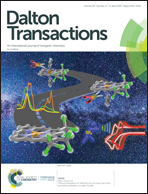MnIV-Oxo complex of a bis(benzimidazolyl)-containing N5 ligand reveals different reactivity trends for MnIV-oxo than FeIV-oxo species†
Abstract
Using the pentadentate ligand (N-bis(1-methyl-2-benzimidazolyl)methyl-N-(bis-2-pyridylmethyl)amine, 2pyN2B), presenting two pyridyl and two (N-methyl)benzimidazolyl donor moieties in addition to a central tertiary amine, new MnII and MnIV-oxo complexes were generated and characterized. The [MnIV(O)(2pyN2B)]2+ complex showed spectroscopic signatures (i.e., electronic absorption band maxima and intensities, EPR signals, and Mn K-edge X-ray absorption edge and near-edge data) similar to those observed for other MnIV-oxo complexes with neutral, pentadentate N5 supporting ligands. The near-IR electronic absorption band maximum of [MnIV(O)(2pyN2B)]2+, as well as DFT-computed metric parameters, are consistent with the equatorial (N-methyl)benzimidazolyl ligands being stronger donors to the MnIV center than the pyridyl and quinolinyl ligands found in analogous MnIV-oxo complexes. The hydrogen- and oxygen-atom transfer reactivities of [MnIV(O)(2pyN2B)]2+ were assessed through reactions with hydrocarbons and thioanisole, respectively. When compared with related MnIV-oxo adducts, [MnIV(O)(2pyN2B)]2+ showed muted reactivity in hydrogen-atom transfer reactions with hydrocarbons. This result stands in contrast to observations for the analogous FeIV-oxo complexes, where [FeIV(O)(2pyN2B)]2+ was found to be one of the more reactive members of its class.



 Please wait while we load your content...
Please wait while we load your content...
